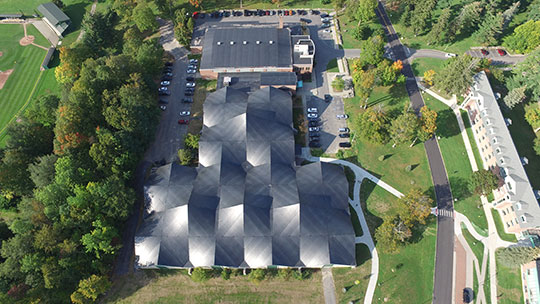In the 2016 study Green and cool roofs to mitigate urban heat island effects in the Chicago metropolitan area: evaluation with a regional climate model by A. Sharma, P. Conry, H. Fernando, Alan F Hamlet, J. J. Hellmann and F. Chen, researchers found another potential negative consequence of using cool roofs for urban heat island mitigation.
Researchers found that green and cool roofs could lead to increased retention of pollutant laden air close to the surface during the daytime.
 FleeceBACK® EPDM – Clarkson University in Potsdam, NY
FleeceBACK® EPDM – Clarkson University in Potsdam, NY
“The modifications to the roof surface energy budget caused by green and cool roofs not only affected the surface and near-surface conditions but also modified the structure of the boundary layer (<2500 m). The lower atmosphere temperature, winds, and relative humidity changed due to reduction in UHI, as vertical mixing and boundary layer depth decreased with green and cool roofs during daytime convective period. The strength of vertical convective rolls and their height decreased. Overall, reduced vertical mixing, weaker convective rolls and less horizontal velocity in lower atmosphere (<0.5 km) may lead to increased retention time of pollutant-laden air close to the surface during daytime, thus causing air quality issues.”
“Both cool and green roofs would lead to decreased vertical mixing as discussed above, a disadvantage from the air quality standpoint.”
“The modifications to the roof surface energy budget caused by green and cool roofs not only affected the surface and near-surface conditions but also modified the structure of the boundary layer (<2500 m). The lower atmosphere temperature, winds, and relative humidity changed due to reduction in UHI, as vertical mixing and boundary layer depth decreased with green and cool roofs during daytime convective period. The strength of vertical convective rolls and their height decreased. Overall, reduced vertical mixing, weaker convective rolls and less horizontal velocity in lower atmosphere (<0.5 km) may lead to increased retention time of pollutant-laden air close to the surface during daytime, thus causing air quality issues.”
Previous studies have documented other potential negative consequences.
These studies indicate that previous government policy decisions mandating the use of white or reflective roofing in certain regions or cities did not fully understand the possible negative consequences to the general public.
Sincerely,

Ronald L. Goodman
Marketing Manager, EPDM Roofing Systems
Ron.Goodman@CarlisleCCM.com
|
